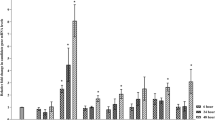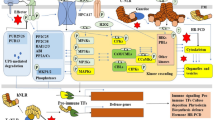Abstract
As maize seedlings germinate into the soil, they encounter an environment teeming with insects seeking rich sources of nutrition. Maize presumably has developed a number of molecular mechanisms to ensure survival at the beginning of its life cycle. Comparative transcription analysis using microarrays was utilized to document the expression of a number of genes with potential defensive functions in seedling tissue. In addition to elevated levels of the genes involved in the biosynthesis of DIMBOA (2,4-dihydroxy-7-methoxy-1,4-benzoxazin-3-one), an anti-insect resistance molecule, other highly expressed genes in the seedling encode the following putative defensive proteins: defensin, hydroxyproline and proline-rich protein, thaumatin-like protein, lipase, cystatin, protease inhibitor, and a variety of proteases. The potential resistance genes identified occurred mainly on chromosomes 1 and 5 in the B73 genome. Analysis of promoters of seven DIMBOA biosynthetic genes identified three transcription factor binding sites that are possibly involved in regulation of the DIMBOA biosynthetic pathway. The results indicate that maize employs a wide variety of potential resistance mechanisms in seedling tissue to resist a possible insect attack.
Similar content being viewed by others
References
Abe M, Whitaker JR (1988) Purification and characterization of a cysteine proteinase inhibitor from the endosperm of corn. Agric Biol Chem 52:1583–1584
Alvarez S, Goodger JQ, Marsh EL, Chen S, Asirvatham VS, Schachtman DP (2006) Characterization of the maize xylem sap proteome. J Proteome Res 5:963–972
Arai S, Matsumoto I, Emori Y, Abe K (2002) Plant seed cystatins and their target enzymes of endogenous and exogenous origin. J Agric Food Chem 50:6612–6617
Argandona VH, Corcuera LJ, Niemeyer HM, Campbell BC (1983) Toxicity and feeding deterrency of hydroxamic acids from Gramineae in synthetic diets against the greenbug, Schizaphis graminum. Entomol. Exp. Appl 34:134–138
Arnason JT, Baum BB, Gale J, Lambert JDH, Bergvinson D, Philogene BJR, Serratos JA, Mihm J, Jewell DC (1994) Variation in resistance of Mexican landraces of maize to maize weevil Sitophilus zeamais, in relation to taxonomic and biochemical parameters. Euphytica 74:227–236
Baker RL, Brown RL, Chen ZY, Cleveland TE, Fakhoury AM (2009) A maize lectin-like protein with antifungal activity against Aspergillus flavus. J. Food Prot 72:120–127
Barriere Y, Riboulet C, Mechin V, Maltese S, Pichon M, Cardinal A, Lapierre C, Lubberstedt T, Martinant JP (2007) Genetics and genomics of lignification in grass cell walls based on maize as model species. Genes Genomes Genomics 1:133–156
Bergvinson DJ, Arnason JT, Hamilton RI (1997) Phytochemical changes during recurrent selection for resistance to the European corn borer. Crop Sci 37:1567–1572
Bing JW, Guthrie WD, Dicke FF, Obrycki JJ (1990) Relation of corn leaf aphid (Homoptera: Aphididae) colonization to DIMBOA content in maize inbred lines. J Econ Entomol 83:1626–1632
Blanco-Labra A, Iturbe C (1981) Purification and characterization of an alpha-amylase inhibitor from maize (Zea mays). J. Food Biochem 5:1–17
Bloch C Jr, Richardson M (1991) A new family of small (5 kDa) protein inhibitors of insect alpha-amylases from seeds or sorghum (Sorghum bicolor (L.) Moench) have sequence homologies with wheat gamma-purothionins. FEBS Lett 279:101–104
Brewbaker JL, Hasegawa Y (1975) Polymorphism of the major peroxidases of maize. In: Markert CL (ed) Isozymes III. Developmental biology. Academic Press, New York, pp 659–673
Cambier V, Hance T, de Hoffman E (2000) Variation of DIMBOA and related compounds content in relation to the age and plant organ in maize. Phytochemistry 53:223–229
Chang WC, Lee TY, Huang HD, Huang HY, Pan RL (2008) PlantPAN: plant promoter analysis navigator, for identifying combinatorial cis-regulatory elements with distance constraint in plant gene groups. BMC Genomics 9:561
Corcuera LJ, Queirolo CB, Argandona VH (1985) Effects of 2-β-d-glucosyl-4-hydroxy-7-methoxy-1,4-benzoxazin-3-one on Schizaphis graminum (Rondani) (Insecta, Aphididae) feeding on artificial diets. Experientia 41:514–516
Cusack M, Pierpoint W (1988) Similarities between sweet protein thaumatin and a pathogenesis-related protein of tobacco. Phytochemistry 27:3817–3821
Dowd PF (1994) Enhanced maize (Zea mays L.) pericarp browning: associations with insect resistance and involvement of oxidizing enzymes. J Chem Ecol 20:2777–2803
Dowd PF (2002) Antiinsectan compounds derived from microorganisms. In: Koul O, Dhaliwal GS (eds) Advances in biopesticides research. Harwood, Amsterdam, pp 13–116
Dowd PF, Johnson ET (2005) Association of a specific cationic peroxidase isozyme with maize stress and disease resistance responses, genetic identification, and identification of a cDNA coding for the isozyme. J Agric Food Chem 53:4464–4470
Dowd PF, Lagrimini LM (1997) The role of peroxidase in host insect defenses. In: Carozzi N, Koziel M (eds) Advances in insect control: The role of transgenic plants. Taylor and Francis, Bristol, PA, pp 195–223
Dowd PF, Vega FE (1996) Enzymatic oxidation products of allelochemicals as a basis for resistance against insects: effects on the corn leafhopper Dalbulus maidis. Nat Toxins 4:85–91
Dowd PF, Johnson ET, Pinkerton TS (2010) Identification and properties of insect resistance-associated maize anionic peroxidases. Phytochemistry 71:1289–1297
Frey M, Schullehner K, Dick R, Fiesselmann A, Gierl A (2009) Benzoxazinoid biosynthesis, a model for evolution of secondary metabolic pathways in plants. Phytochemistry 70:1645–1651
Guthrie WD, Tseng CT, Russell WA, Coats JR, Robbins JC, Tollefson JJ (1986) DIMBOA content at seven stages of plant development in a maize synthetic cultivar. J. Kans. Entomol. Soc 59:356–360
Hedge P, Qi R, Abernathy K, Gay C, Dharap S, Gaspard R, Hughes JE, Snesrud E, Lee N, Quackenbush J (2000) A concise guide to cDNA microarray analysis. Biotechniques 29:548–562
Johannesson H, Wang Y, Engström P (2001) DNA-binding and dimerization preferences of Arabidopsis homeodomain-leucine zipper transcription factors in vitro. Plant Mol Biol 45:63–73
Juarez MT, Kul JS, Thomas J, Heller BA, Timmermans MCP (2004) microRNA-mediated repression of rolled leaf1 specifies maize leaf polarity. Nature 428:84–88
Klun JA, Robinson JF (1969) Concentration of two 1,4-benzoxazinones in dent corn at various stages of development of the plant and its relation to resistance of the host plant to the European corn borer. J Econ Entomol 62:214–220
Koiwa H, Shade RE, Zhu-Salzman K, D’Urzo MP, Murdock LL, Bressan RA, Hasegawa PM (2000) A plant defensive cystatin (soyacystatin) targets cathepsin L-like digestive cysteine proteinases (DvCALs) in the larval midgut of western corn rootworm (Diabrotica virgifera virgifera). FEBS Lett 471:67–70
Kushmerick C, Castro MD, Cruz JS, Bloch CJ, Beirao PSL (1998) Functional and structural features of gamma-zeathionins, a new class of sodium channel blockers. FEBS Lett 440:302–306
Lay FT, Anderson MA (2005) Defensins—components of the innate immune system in plants. Curr. Protein Pept. Sci 6:85–101
Liu ZL, Slininger PJ (2007) Universal external RNA controls for microbial gene expression analysis using microarray and qRT-PCR. J Microbiol Methods 68:486–496
McMullen MD, Simcox KD (1995) Genomic organization of disease and insect resistance genes in maize. Mol Plant Microbe Interact 8:811–815
McMullen MD, Frey M, Degenhardt J (2009) Genetics and biochemistry of insect resistance in maize. In: Bennetzen JL, Hake SC (eds) Handbook of maize: its biology. Springer, New York, pp 271–289
Muthukrishnan S, Liang GH, Trick HN, Gill BS (2001) Pathogenesis-related proteins and their genes in cereals. Plant Cell Tissue Organ Cult 64:93–114
Niemeyer HM (1988) Hydroxamic acids (4-hydroxy-1,4-benzoxazin-3-ones), defence chemicals in the Gramineae. Phytochemistry 27:3349–3358
Oppert B, Morgan TD, Hartzer K, Lenarcic B, Galesa K, Brzin J, Turk V, Yoza K, Ohtsubo K, Kramer KJ (2003) Effects of proteinase inhibitors on digestive proteinases and growth of the red flour beetle, Tribolium castaneum (Herbst) (Coleoptera: Tenebrionidae). Comp Biochem Physiol C. Toxicol. Pharmacol 134:481–490
Park HC, Kim ML, Kim HS, Park JH, Jung MS, Shen M, Kang CH, Kim MC, Lee SY, Cho MJ, Chung WS, Yun DJ (2010) Specificity of DNA sequences recognized by the zinc-finger homeodomain protein, GmZF-HD1 in soybean. Phytochemistry 71:1832–1838
Robinson JF, Klun JA, Guthrie WD, Brindley TA (1982) European corn borer (Lepidoptera: Pyralidae) leaf feeding resistance: DIMBOA bioassays. J. Kans. Entomol. Soc 55:357–364
Sadasivam S, Thayumanavan B (2003) Molecular host plant resistance to pests. Marcel Dekker, New York
Schoen CC, Lee M, Melchinger AE, Guthrie WD, Woodman WL (1993) Mapping and characterization of quantitative trait loci affecting resistance against 2nd-generation European corn borer in maize with the aid of RFLPs. Heredity 70:648–659
Simpson SD, Nakashima K, Narusaka Y, Seki M, Shinozaki K, Yamaguchi-Shinozaki K (2003) Two different novel cis-acting elements of erd1, a clpA homologous Arabidopsis gene function in induction by dehydration stress and dark-induced senescence. Plant J 33:259–270
Smith CM, Kahn ZR, Pathak MD (eds) (1994) Techniques for evaluating insect resistance in crop plants. CRC Press, Boca Raton, FL
Stiefel V, Ruiz-Avila L, Raz R, Pilar VM, Gomez J, Pages M, Martinez-Izquierdo JA, Ludevid MD, Langdale JA, Nelson T (1990) Expression of a maize cell wall hydroxyproline-rich glycoprotein gene in early leaf and root vascular differentiation. Plant Cell 2:785–793
Tan QKG, Irish VF (2006) The Arabidopsis zinc finger-homeodomain genes encode proteins with unique biochemical properties that are coordinately expressed during floral development. Plant Physiol 140:1095–1108
Thackray DJ, Wrattent SD, Edwards PJ, Niemeyer HM (1990) Resistance to the aphids Sitobion avenae and Rhopalosiphum padi in Gramineae in relation to hydroxamic acid levels. Annals App. Biol 116:573–582
Tran LSP, Nakashima K, Sakuma Y, Osakabe Y, Qin F, Simpson SD, Maruyama K, Fujita Y, Shinozaki K, Yamaguchi-Shinozaki K (2006) Co-expression of the stress-inducible zinc finger homeodomain ZFHD1 and NAC transcription factors enhances expression of the ERD1 gene in Arabidopsis. Plant J 49:46–63
Turk B, Turk D, Salvesen GS (2002) Regulating cysteine protease activity: essential role of protease inhibitors as guardians and regulators. Curr Pharm Des 8:1623–1637
Vignols F, Jose-Estanyol M, Caparros-Ruiz D, Rigau J, Puigdomenech P (1999) Involvement of a maize proline-rich protein in secondary cell wall formation as deduced from its specific mRNA localization. Plant Mol Biol 39:945–952
Windhövel A, Hein I, Dabrowa R, Stockhaus J (2001) Characterization of a novel class of plant homeodomain proteins that bind to the C4 phosphoenolpyruvate carboxylase gene of Flaveria trinervia. Plant Mol Biol 45:201–214
Wittstock U, Gershenzon J (2002) Constitutive plant toxins and their role in defense against herbivores and pathogens. Curr Opin Plant Biol 5:300–307
Yang G, Isenhour DJ, Espelie KE (1991) Activity of maize leaf cuticular lipids in resistance to leaf-feeding by the fall armyworm. Fla Entomol 74:229–236
Zhang NY, Jones BL, Tao P (1997) Purification and characterization of a new class of insect alpha-amylase inhibitors from barley. Cereal Chem 74:119–122
Acknowledgments
We thank David Lee, Mark Doehring, and Dr. Menggen Ma for technical assistance. Mention of trade names or commercial products in this article is solely for the purpose of providing specific information and does not imply recommendation or endorsement by the US Department of Agriculture. USDA is an equal opportunity provider and employer. Funding was provided by the National Science Foundation Plant Genome Research Initiative (No. 0820367 to ROM) for statistical software.
Author information
Authors and Affiliations
Corresponding author
Additional information
Communicated by R. Waugh.
Electronic supplementary material
Below is the link to the electronic supplementary material.
438_2011_626_MOESM4_ESM.doc
Supplementary material 4 (DOC 200 kb) Supplementary Figure 4: Cluster analysis of maize genes up- and down-regulated in seedlings (T0), 4-leaf (T1), or 6-leaf shoots (T2). The dendrogram on top of the cluster illustrates the relationship among the three life stages. Log 2 scaled ratio values were calculated between the three life stages. Genes up-regulated appear in red (positive log-ratio values), and those that were down-regulated appear in blue (negative log-ratio values). Each row along the three columns corresponds to a single gene, and a color scale is presented below the figure
Rights and permissions
About this article
Cite this article
Johnson, E.T., Dowd, P.F., Liu, Z.L. et al. Comparative transcription profiling analyses of maize reveals candidate defensive genes for seedling resistance against corn earworm. Mol Genet Genomics 285, 517–525 (2011). https://doi.org/10.1007/s00438-011-0626-z
Received:
Accepted:
Published:
Issue Date:
DOI: https://doi.org/10.1007/s00438-011-0626-z




